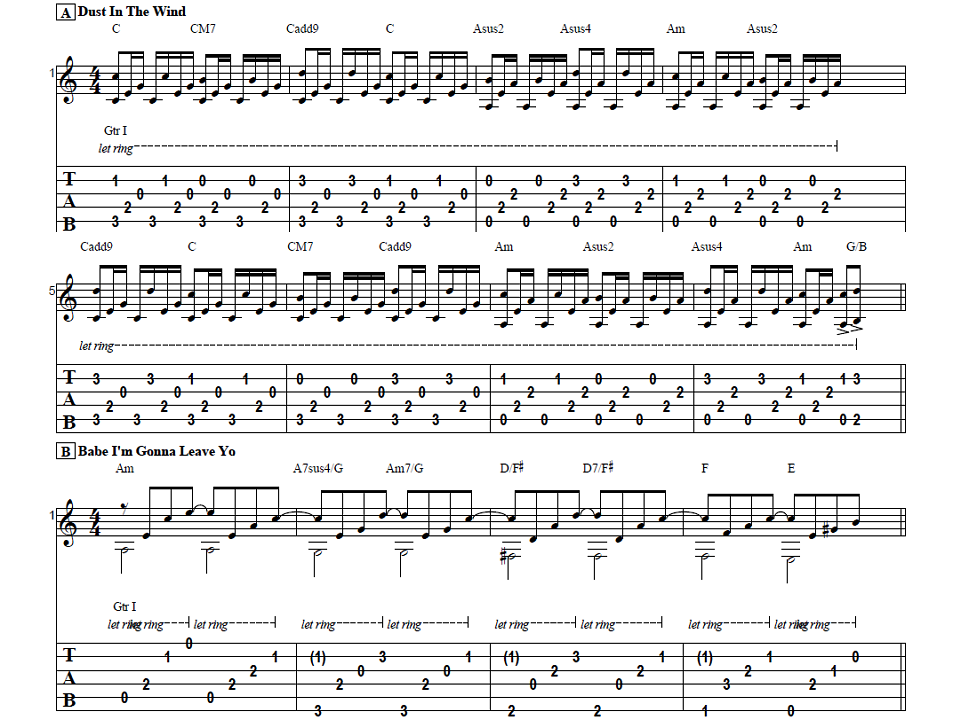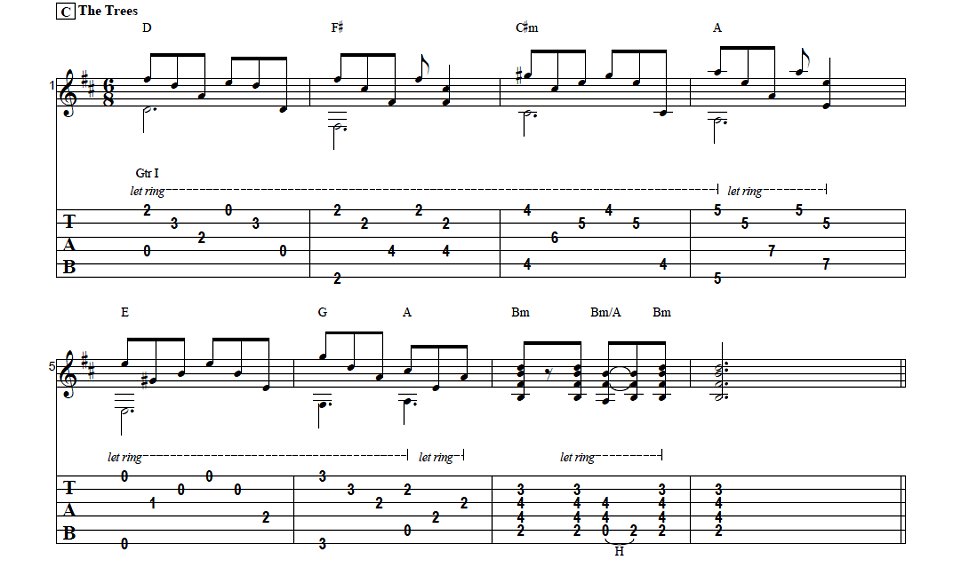Learn to play 3 fun and easy fingerstyle guitar riffs with Guitar Control instructor Darrin Goodman, aka Uncle D. Be sure to get the free tabs to go along with the step by step video instruction and you will be sure to impress your friends and family.


Introduction
How’s it going everybody? This is Darrin with GuitarControl.com bringing you this video lesson and today I’ve got three iconic finger style riffs for you.
Right now Guitar Control is giving away this free chord chart and there’s a link down the description where you can get yours. Every chord you could ever need all neatly compiled into one sheet and it’s in PDF format; so print it off, throw it in your gig bag, put it where you practice so that way you can have any chord you could ever need at a glance and it’s a free download.
So be sure to click on the link in the description for the tab and let’s get close up and take a look at these.
Fingerstyle Riff-1 – Dust In The Wind – Kansas
All right so the first one we’re going to look at is riff from Dust In The Wind. Now this is a real… in fact the first two here we’re looking at are really good exercises just for both of your hands for finger style guitar. So this first one here we’re going to start off we’ve got a C chord; so on this we’re going to be playing just we’re not going to be playing the low E string or the high E string. So your thumb will be playing the A string, your first finger will be playing the D string, your second finger will be playing the G string and your third finger will be playing the B string. So we start off we’re going to go thumb and third finger together and then first second; so it’s if you know P-I-M-A it’s P-A-I-M-P-A-I-M-A… Now when we go to the second measure we can do a C add nine (Cadd9); so all we’re gonna do is take our pinky and put it down here onto the third fret of the B string but you wanna keep that first finger handy because we’re gonna be going back to the C… so that’s like the first two measures… Okay then on the third measure we’re going to go to an A suspended two (Asus2); so basically if you just move your third finger down to the second fret of the G string like you’re making an A minor (Am) and then just take your first finger off. So starting on the third measure… then halfway through that we’re going to go to A suspended four (Asus4); so we’re just going to take our keep this shape here but we’re going to put our pinky down here onto the third fret of the B string and then to A minor, Asus2 and then we’re back to Cadd9, C, C major seven (CM7), so we just take our first finger off, back to the Cadd9 to Am, Asus2, so we just take our first finger off, Asus4, back to Am and then those are the little pickups to go into the vocal part there. So that’s like basically the intro…
Fingerstyle Riff-2 – Babe I’m Gonna Leave You – Led Zeppelin
All right the next one I’m going to look at is Babe I’m Gonna Leave You by Led Zeppelin. So this one here starts off with Am and it’s got kind of a similar thing that was happening with Dust In The Wind, but more on the lower strings, we’ll see here in a second. So we start off with the Am and we go; A, D, B, E, and we’re going to go P, your thumb plays the A string. There’s a couple you could go, P and then I to pick up the D string or you could just do your thumb and then your first and second finger to pick up the B and high E string or your third and fourth… so either way, but when I get up here to the high E string I use my second and third finger just because as a general rule you can just keep know your fingers together; on a lot of a lot of songs just move the shape up or down as a set of strings… so that’s our first measure. Now we’re going to go to an A 7 suspended 4 over G (A7sus4/G), it sounds all crazy and stuff, but all we’re gonna do is just take our third finger and move it from here on the second fret of the G string, we’re gonna move it down to the third fret of the low E string and then our first finger we’re gonna still keep it here to go to the first fret and we’re gonna also have our pinky here to go on the third fret on the B string… So E, D, G, B; so my thumb first second third and then we’re going to do that again but we’re going to move the note on the B string from the third fret to the first fret and that’s our first two measures… Then we’re going to a D over F sharp (D/F#) and how I like to do for this one is going from here… I move my middle finger from the second fret of the A string to the second fret of the low E and then bring my third finger up to the second fret of the G string and then I can use my pinky again to pick up the third fret of the B string… so that’s the first half of that third measure. Now we’ve got D seven over F sharp (D7/F#); so all we’re going to do is take our pinky off and our first fingers on the first fret of the B string and that’s our first three measures. Then the very last one we just go to an F major barre chord and we’re gonna play 6, 4, 3, 2, or P-I-M-A and then you can just slide down and make it an E major, same picking, and then it would just start over again…
Fingerstyle Riff-3 – The Trees – Rush
All right and then the last one to look at is The Trees By Rush. So this is kind of weird because it’s in it’s in 6/8, but it’s just using a bunch of chords that you probably already know, but there is a lot of barre chords, so if you’re a beginner you probably you may have an issue with barre chords, but this is a another one that’s kind of a great exercise. So we’re going to start off with D and we’re going to play the high E string and the D string together; so my thumb is playing the D string and my first finger is playing the G string, second finger on the B string and third finger on the high E string. So we’ve got one and, two; so D and E together to B to G and then we’re going to take our middle finger off, E, B, whoops, back to the D string… Then we’re going to go to an F sharp major (F#); so we’re going to barre all the way across the second fret, second finger onto the third fret of the G string, third finger onto the fourth fret of the A string and fourth finger onto the fourth fret of the D string. Now we’re going to do that same kind of that same timing, but now we’re going to do the low E string and the high E string together to the B string and then to the D string, back to the high E string and then the B string and D string together. Now we’re going to go to a C sharp minor (C#m); so we’re going to move up and we’re going to take this shape and move it up a whole step so now you’re barring at the fourth fret and then move all of your other fingers up a string each so that’ll bring your second finger to the fifth fret of the B string and your third finger to the sixth fret of the D string and your fourth finger to the sixth fret of the G string… so A and E together, high E to the G string, B string, high E string back to the B string… and then end on the A string one and, two and, three and… Now we’re going to go to A major, so we’re going to shift up one fret this time and now we’re going to take these fingers and move them back down; so now our middle finger to the G string sixth fret and our third finger to the seventh fret of the A string and our first finger to this seventh fret of the D string and the picking for this one is the same as it was on the second measure, except this time instead of hitting the B string and D string together, we’re supposed to hit the B string and the A string together… Then we’re going to go to a E major; so we’re going to come all the way down here so we’re going to go E and E together to the G string, so the G string with your first finger, B string, high E string with your third finger again, back to the B string and then the D to A G… so on the G both of these strings together, to the B string, to the G string and then we’re going to switch to an A major; so the A string and B string together to D and G. Then a Bm, so just the same as the C#m we did before, we’re just moving it down a whole step; so you’re barring at the second fret instead of the fourth fret and we’re going to play the A, D, G and B string simultaneously, one and, two and, three and. So we pluck them in together one, and then we rest on the and of one and then we do it again on the downbeat of two and then on the and of two we’re going to take our first finger off and we’re gonna play the A, D and G string and then hammer our first finger back to the second fret and then pluck the whole chord again and that’s on the and of three. And then on the last measure we just hit it again and that’s the whole thing…
Conclusion
All right so there you have it, three iconic finger style guitar riffs. So if you like this lesson be sure to give me a thumbs up and leave a comment down below if you have any questions about this or other guitar related topics. If you’ve not already done so please subscribe to the channel and hit that notification bell so you don’t miss any of the content that we upload throughout the week. Well that is all I have for you today. Thanks for watching and have a great day.



